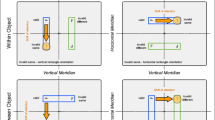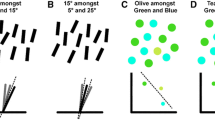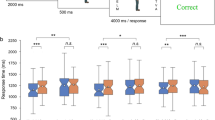Abstract
The orientation of a nontarget in a location-cuing paradigm has been shown to affect accuracy of identification of target orientation when modified plus-signs (Ts) are the stimuli. In the current study, similar effects were found with Landolt C (C) stimuli. Both shapes of targets were identified by orientation. Moreover, targets were affected by nontargets whether both target and nontarget were the same shape or if they were different shapes. A single nontarget with an orientation that matched that of the target improved accuracy of identification of target orientation, whereas a nontarget with an orientation that did not match that of the target impaired accuracy of identification of target orientation, even though the nontargets appeared in locations that were never cued and could never contain targets. The data are consistent with either the Variable and Permeable Filters metaphor or a response competition account.
Similar content being viewed by others
Author information
Authors and Affiliations
Additional information
Received: 1 July 1998 / Accepted: 22 October 1998
Rights and permissions
About this article
Cite this article
Chastain, G., Cheal, M. Influences of target and nontarget shapes on target identification. Psychological Research Psychologische Forschung 62, 266–274 (1999). https://doi.org/10.1007/s004260050056
Issue Date:
DOI: https://doi.org/10.1007/s004260050056




